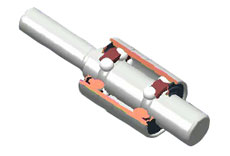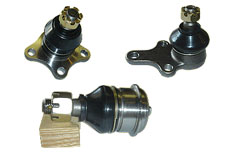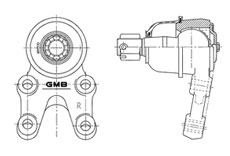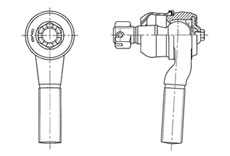Basic design of GMB products
Quality and cost would be almost determined when the product is designed. GMB products are designed under the trade
mark "Global Management Business"
HIGH QUALITY PRODUCTS
QUICK DELIVERY
COMPETITIVE PRICE
BEST SERVICE
We GMB are making a continuous effort to guarantee the performance and quality based on our well-experienced knowledge.
Feature
 A universal joint is fitted between the driveshaft and the differential axle to transmit power through the axis of rotation.
Perfectly smooth rotation is required, in order to handle the constantly changing angles of the rear axle caused by
the vertical movement of uneven surfaces transmitted through the suspension system. In other words, a universal joint
efficiently transmits power through both fixed and fluctuating angles. Moreover, since the universal joint is lightweight and
compact with superior durability, it has proved to be a safe and positive product for power transfer in Automotive and
Industrial applications. In recent years, we have been working to develop and produce the press type bearing which
is aimed at improvement in intensity and durability and reduces cost further.
A universal joint is fitted between the driveshaft and the differential axle to transmit power through the axis of rotation.
Perfectly smooth rotation is required, in order to handle the constantly changing angles of the rear axle caused by
the vertical movement of uneven surfaces transmitted through the suspension system. In other words, a universal joint
efficiently transmits power through both fixed and fluctuating angles. Moreover, since the universal joint is lightweight and
compact with superior durability, it has proved to be a safe and positive product for power transfer in Automotive and
Industrial applications. In recent years, we have been working to develop and produce the press type bearing which
is aimed at improvement in intensity and durability and reduces cost further.
Structure
 A universal joint has four needle roller bearings that provide the strength and life which is most important and both the
axes of the spider are inserted into two yokes. In the bearing, a seal is located to prevent dust, water, etc.
From ingress and to prevent grease egress. For heavy duty vehicles with high torque transmission, such as large size
vehicles and various industrial machine vehicles, a wing type (3 kinds: block, wing, delta) is used. Bolt-fastening
mechanism and key-way are incorporated to the bearing and a precise circle is on its back. By receiving the torque
through the key-way, even if a bolt is loosely tightened, the shearing stress does not apply to the bolt.
A universal joint has four needle roller bearings that provide the strength and life which is most important and both the
axes of the spider are inserted into two yokes. In the bearing, a seal is located to prevent dust, water, etc.
From ingress and to prevent grease egress. For heavy duty vehicles with high torque transmission, such as large size
vehicles and various industrial machine vehicles, a wing type (3 kinds: block, wing, delta) is used. Bolt-fastening
mechanism and key-way are incorporated to the bearing and a precise circle is on its back. By receiving the torque
through the key-way, even if a bolt is loosely tightened, the shearing stress does not apply to the bolt.
Feature
 The steering joint is a type of universal joint which is used in a steering mechanism part. The main feature is that it
is miniature and lightweight since the rotation is slow and the torque requirement is small. Electrical drive steering
in recent prevalence requires more tensile strength.
The steering joint is a type of universal joint which is used in a steering mechanism part. The main feature is that it
is miniature and lightweight since the rotation is slow and the torque requirement is small. Electrical drive steering
in recent prevalence requires more tensile strength.
Structure
Same as the drive train universal joint in essence but it is made in much smaller design.
Feature
 The engine for automobiles uses gasoline and light oil as fuel. They are evaporated first, then compressed and ignited
for explosions which give the engine the rotating power to crank shaft. In the engine, a gas explosion always occurs
during operation of the vehicle and the temperature of the gas increases up to 1500-2000 degrees. Therefore, in order
to prevent the siezure or meltdown of the engine by this temperature, there is the necessity of always maintaining the
proper temperature. Such equipment is called a cooling system and there are air cooling and water cooling technical options.
The positive circulation cooling device of water is almost exclusively used for automobiles at present in the industry.
Our water pump, which is the heart of the engine's cooling system, uses aluminum die casting and press-impeller to attain
the weight saving. Furthermore, we offer a long lasting water pump which minimizes power loss by using a consolidated
bearing and unitized mechanical seal with a low torque structure. Our water pump enhances fuel economy and contributes
to saving energy.
The engine for automobiles uses gasoline and light oil as fuel. They are evaporated first, then compressed and ignited
for explosions which give the engine the rotating power to crank shaft. In the engine, a gas explosion always occurs
during operation of the vehicle and the temperature of the gas increases up to 1500-2000 degrees. Therefore, in order
to prevent the siezure or meltdown of the engine by this temperature, there is the necessity of always maintaining the
proper temperature. Such equipment is called a cooling system and there are air cooling and water cooling technical options.
The positive circulation cooling device of water is almost exclusively used for automobiles at present in the industry.
Our water pump, which is the heart of the engine's cooling system, uses aluminum die casting and press-impeller to attain
the weight saving. Furthermore, we offer a long lasting water pump which minimizes power loss by using a consolidated
bearing and unitized mechanical seal with a low torque structure. Our water pump enhances fuel economy and contributes
to saving energy.
Structure
 The cooling water that gets hot in the jacket is sent to the upper part of the radiator, then when it moves down the cooling pipe, the fan sucks the air from the outside and cools down the water so that it can be circulated in the jacket again and make the engine stay cool. In this positive circulation cooling mechanism the movement of the water pump is powered by the engine rotation through flange on the water pump bearing shaft. The impeller on the other end of bearing shaft runs and pushes the water by centrifugal force into the engine's water passage.
The cooling water that gets hot in the jacket is sent to the upper part of the radiator, then when it moves down the cooling pipe, the fan sucks the air from the outside and cools down the water so that it can be circulated in the jacket again and make the engine stay cool. In this positive circulation cooling mechanism the movement of the water pump is powered by the engine rotation through flange on the water pump bearing shaft. The impeller on the other end of bearing shaft runs and pushes the water by centrifugal force into the engine's water passage.
Feature
 A fan clutch controls the
rotation of a fan because it reacts to the temperature of air which
passes through the radiator and has the role to maintain the heat
balance of an engine cooling system at the best condition by
changing the amount of air flow. It is designed to respond quickly
to temperature that changes every second, such as high speed driving
and traffic congestion, and to change a fan speed continuously. It
reduces a fanning noise while it suppresses power and decreases mpg,
and it contributes to having a comfortable driving
environment.
A fan clutch controls the
rotation of a fan because it reacts to the temperature of air which
passes through the radiator and has the role to maintain the heat
balance of an engine cooling system at the best condition by
changing the amount of air flow. It is designed to respond quickly
to temperature that changes every second, such as high speed driving
and traffic congestion, and to change a fan speed continuously. It
reduces a fanning noise while it suppresses power and decreases mpg,
and it contributes to having a comfortable driving
environment.
Structure
 The rotation force of the fan is transmitted through the silicone oil inside the fan clutch driven by the belt and the rotation of the engine which is the principal source of power. This silicone oil has a highly stable density.
By a large amount of silicone oil in the working chamber the fan speed increases when the atmosphere's temperature is high. Conversely, when the temperature is low, a small amount of silicone oil is regulated into the chamber and the fan speed slows down. It has a structure of adjusting heat balance of engine.
The rotation force of the fan is transmitted through the silicone oil inside the fan clutch driven by the belt and the rotation of the engine which is the principal source of power. This silicone oil has a highly stable density.
By a large amount of silicone oil in the working chamber the fan speed increases when the atmosphere's temperature is high. Conversely, when the temperature is low, a small amount of silicone oil is regulated into the chamber and the fan speed slows down. It has a structure of adjusting heat balance of engine.
Feature
 This bearing is located in the front of an internal combustion engine. It provides tension to the belt which drives from the crankshaft, to the cam shaft, alternator, air compressor, power steering pump, and water pump. It must handle high temperatures, high-speed rotation, and belt vibration because of contiguity in the engine used in order to make the direction of a belt change. These bearings are designed against different specification from normal deep groove bearings. These bearing are divided roughly into two types and identified by the usage, respectively.
This bearing is located in the front of an internal combustion engine. It provides tension to the belt which drives from the crankshaft, to the cam shaft, alternator, air compressor, power steering pump, and water pump. It must handle high temperatures, high-speed rotation, and belt vibration because of contiguity in the engine used in order to make the direction of a belt change. These bearings are designed against different specification from normal deep groove bearings. These bearing are divided roughly into two types and identified by the usage, respectively.
1. Tensioner bearing: Bearing which applies tension to the drive belt, and prevents slack.
2. Idler bearing: Bearing which affects a
change in the angle of direction which a belt runs or to adjust
contact width with a pulley.
Structure
 Sealed groove bearing is usually used and it also has built-in heat-resistant grease, a seal, and retainer and the structure can withstand a temperature change or change of belt tension when the car is running.
Sealed groove bearing is usually used and it also has built-in heat-resistant grease, a seal, and retainer and the structure can withstand a temperature change or change of belt tension when the car is running.
1. Tensioner bearing: The rotation center is movable in order to give tension to the belt.
2. Idler Bearing: Unitized with the pulley.
Product function
The following are important functions of these indispensable parts for the smooth drive of the belt system.
1. To add initial tension by using the pivot hole and eccentric hole which absorb tension changes in the timing belt where the temperature changes when the engine is running.
2. To prevent any belt-skip, which would cause mis-matching of the valve timing between crank shaft and cam shaft.
Feature
 This type of water pump
bearing is mainly used in automotive engine. Grease-contained double
race unitized construction enables the shaft to enlarge the
diameter, then consequently to increase the load capacity of the
bearing. The shaft which is a inner race at the same time is longer
than outer race and carries and holds a impeller and
flange/pulley.
This type of water pump
bearing is mainly used in automotive engine. Grease-contained double
race unitized construction enables the shaft to enlarge the
diameter, then consequently to increase the load capacity of the
bearing. The shaft which is a inner race at the same time is longer
than outer race and carries and holds a impeller and
flange/pulley.
Structure
 Market demand is trending towards the 10 year/100,000-mile guarantee as time progresses and pump failures are more noticeable as engines last longer. When we investigate a defective pump after usage, we can find the following potential causes of early degradation of the bearing - sealing defect (water invasion), breakage, an unsuitable clearance value, faulty load (too tight tension on pulley drive), the slipping effect of a partial load (too loose tension on pulley drive), foreign substances mixing from the outside, overheating occurring from vibration and other external factors, etc., unusual wear, and flaking of bearing. The Ball track of the bearing must guide the balls in as perfect an orbit as possible to rotate smoothly and normally. Also, even if each part's tolerance accuracy is matched and maintained, an orbital side loading usually acts as the maximum weak point, and subsequently will lead to degradation damage which results in an orbital imbalance between the drive pulley and rollers. We improve the degree of purity by washing each part thoroughly before assembly which is then carried out by an automated machine to apply the exact charge of grease and fit the oil seal before a 100% test releases the bearing for use. Such manufacturing precision improves the life and guarantees the stability of the bearing and is carefully detailed in the drawings and standards laid down by GMB.
Market demand is trending towards the 10 year/100,000-mile guarantee as time progresses and pump failures are more noticeable as engines last longer. When we investigate a defective pump after usage, we can find the following potential causes of early degradation of the bearing - sealing defect (water invasion), breakage, an unsuitable clearance value, faulty load (too tight tension on pulley drive), the slipping effect of a partial load (too loose tension on pulley drive), foreign substances mixing from the outside, overheating occurring from vibration and other external factors, etc., unusual wear, and flaking of bearing. The Ball track of the bearing must guide the balls in as perfect an orbit as possible to rotate smoothly and normally. Also, even if each part's tolerance accuracy is matched and maintained, an orbital side loading usually acts as the maximum weak point, and subsequently will lead to degradation damage which results in an orbital imbalance between the drive pulley and rollers. We improve the degree of purity by washing each part thoroughly before assembly which is then carried out by an automated machine to apply the exact charge of grease and fit the oil seal before a 100% test releases the bearing for use. Such manufacturing precision improves the life and guarantees the stability of the bearing and is carefully detailed in the drawings and standards laid down by GMB.
Feature
 Suspension parts are fitted
in order to ease the external force and absorb the bounce of wheel
by spring for adjusting ride height as well as more comfortable
ride.
Suspension parts are fitted
in order to ease the external force and absorb the bounce of wheel
by spring for adjusting ride height as well as more comfortable
ride.
Car body and wheels are linked by springs and steering
linkages such as suspension arms and more.
Ball joint is one of
the most important suspension parts which is used for not only
linkages between car body and wheels but also fills the role of
pivot on turning the steering wheel.
Structure
 GMB Ball Joints are designed in order to correspond to the loading
against all directions as running, cowering and braking by using
sphere ball stud, which is retained by resinous ball sheet for
maintenance free.
GMB Ball Joints are designed in order to correspond to the loading
against all directions as running, cowering and braking by using
sphere ball stud, which is retained by resinous ball sheet for
maintenance free.
We build them with a cold formed, heat-treated stud for superior strength and durability. Despite you do not need to grease them up as a normal use, grease lube is attached to satisfy the customer's needs.
Feature
 Tie-rods are one of the center pieces of a Vehicle's chassis system which turns a direction
of Vehicle via steering wheel.
Tie-rods are one of the center pieces of a Vehicle's chassis system which turns a direction
of Vehicle via steering wheel.
Turning steering wheel transmits
the torque to the steering gear through the column shaft and
steering joints.
The torque which is converted into
reciprocating motion on the steering gear turns the direction of
wheels via tie-rod ends and steering knuckles.
Tie-rod ends are
a kind of ball joints which link the steering gear and knuckles,
commonly fitted at both ends of tie-rod.
There are 2 different
kinds of tie-rods fitted to both right / left wheel that depend on
the type of steering gear.
Recirculation ball nut type gear uses
2 tie-rod ends at both ends and rack / pinion type gear uses a
tie-rod end to the gear side, also a rack end to the steering
knuckle side.
Structure
 The
schematic design of GMB tie-rod ends are as same as our ball joints
except it connected to the housing by screw thread for adjusting
alignment. Also, the ball joint of rack end is coated by dust cover
for maintenance free. The
schematic design of GMB tie-rod ends are as same as our ball joints
except it connected to the housing by screw thread for adjusting
alignment. Also, the ball joint of rack end is coated by dust cover
for maintenance free.
|
 |

|
29.11.2007
Himeji Daiichi Kogyo Co., Ltd company has issued supplement No.009-1 to the existing catalogue of
production Vol.11.
Details01.11.2007
GMB Corporation company published bulletin of new production No.025.
Details01.10.2007
GMB Corporation company published bulletin of new production No.025.
Details01.09.2007
GMB Corporation company published bulletin of new production No.023.
Details01.08.2007
GMB Corporation company published bulletin of new production No.022.
Details01.07.2007
GMB Corporation company published bulletin of new production No.021.
Details01.06.2007
GMB Corporation company published bulletin of new production No.020.
Details01.05.2007
GMB Corporation company published bulletin of new production No.019.
Details01.04.2007
GMB Corporation company published bulletin of new production No.018.
Details01.03.2007
GMB Corporation company published bulletin of new production No.017.
Details01.02.2007
GMB Corporation company published bulletin of new production No.016.
Details01.01.2007
GMB Corporation company published bulletin of new production No.015.
Details12.05.2006
Himeji Daiichi Kogyo Co., Ltd company has issued supplement No.006 to the existing catalogue of
production Vol.10.
Details11.04.2006
Himeji Daiichi Kogyo Co., Ltd company has issued supplement No.007 to the existing catalogue of production Vol.10.
Details26.02.2006
Himeji Daiichi Kogyo Co., Ltd company has issued supplement No.006-4 to the existing catalogue of
production Vol.10.
Details28.01.2006
Eiken Industries Co., Ltd company has issued the new catalogue for 2006.
Details
19.01.2006
Himeji Daiichi Kogyo Co., Ltd company has issued supplement No.009-1 to the existing catalogue of
production Vol.10.
Details |
 |
|

